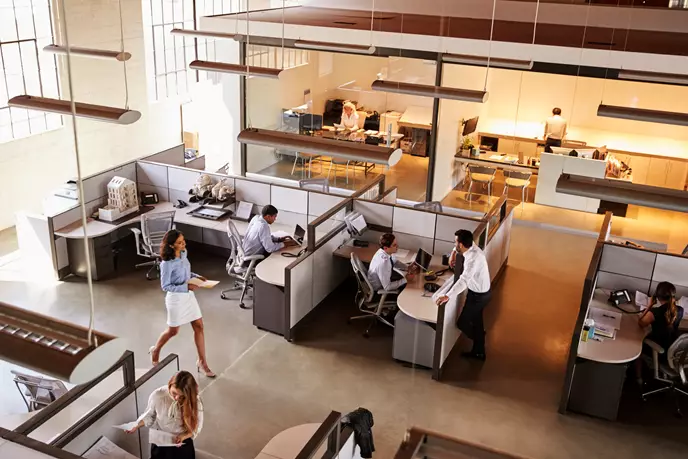
Hollywood's Lessons on Workplace Productivity
Lights, cameras, cubicles!
It’s no secret that our beloved movies have shaped our perceptions and provided a fascinating glimpse into the corporate world. From iconic boardroom scenes to quirky office spaces, these fictional work environments have been curated to set the stage for unforgettable stories.
Think of the fast-paced newsroom in “The Devil Wears Prada” or the tech-savvy playground in “The Social Network.” The offices in these movies aren’t just a backdrop; they are integral in shaping the characters, their struggles, and triumphs.
But what really makes any of these office environments unproductive or super productive?
Whether it’s the soul-sucking monotony of cubicles or the high-octane adrenaline of a startup company trying to make it, let’s look at some of Hollywood’s best-hidden life lessons on what makes these offices tick!
What is Workplace Productivity?
A workplace with high productivity would indicate a flourishing office environment. Tasks are being completed efficiently and effectively, with the overall profitability and key metrics of the organisation improving. In the real world, boosting business productivity and collaboration relies heavily on employees leveraging each other’s strengths to achieve their company’s goals. It’s a very structured process that demands oversight, and people get along with one another. But in the movie world, that doesn’t really make for an interesting plot!
Unproductive Office Environments
![]()
Let’s start with the ones that seem the most fun to watch on-screen but would be terrible to experience in our daily lives.
The Wolf of Wall Street: A Masterclass in Workplace Productivity Gone Wrong
Need we introduce this masterpiece?
Few films epitomize the chaotic and counterproductive nature of an office than The Wolf of Wall Street. Within the film's first five minutes, Martin Scorsese takes us on a wild journey through the morally dubious world of high finance.
Let’s see why an environment where work takes a back seat and extravagant party culture because the focus doesn’t end well.
Party, party, party: The Downfall of Productivity in the Workplace
Success is great and should be celebrated!
But The Wolf of Wall Street displays an office where hedonism knows no bounds. Employees are less interested in planning their next big project and more excited to embark on a relentless carnival of debauchery.
These quaaludes, champagne showers, and promiscuous activities all lead to an excessive party culture that results in a staggering lack of focus on work. Diligence and precision in tasks become an afterthought while pursuing pleasure remains supreme.
The desks are there, the elaborate boardrooms are there, the technology is there, but the minds are in the wrong place. This is a prime example of an office environment becoming a breeding ground for unproductivity.
“Cramped, noisy and dehumanizing. Maybe the density of the desking suits stock trading firms but most companies will struggle to retain or motivate stuff,” said Office Interior Designer Daniel James.
We can’t even blame the office design for this one.
Toxic culture: The secret Killer of Productivity
Immorality and unethical atmospheres play an interesting role in movies that involve an office.
The initial culture of deception and greed shows insurmountable levels of career success, only to come crashing down. The same is true of Jordan Belfort played by Leonardo DiCaprio, where unscrupulous tactics and illegal activities take center stage.
And it seriously kills the productivity of an environment where trust and teamwork are nonexistent. Up to 27% of people decide to leave such workplaces as quickly as possible.
A hostile work environment that undermines the organization’s integrity is productivity’s kryptonite. Take this movie as a precautionary tale where moral bankruptcy and wild party culture lead to paying a steep price.
The Office: Team-Building in a Mundane Setting
Those who have seen The Office will definitely resonate with the seemingly mundane setting of Dunder Mifflin’s Scranton branch, where pranks and personal relationships hamper productivity.
We’re thrown into a rather sterile and uninspiring atmosphere. A sea of cubicles creates monotony and lack of privacy, with characters like Jim, Pam, and Dwight each working in their partitioned sections.
There’s an obvious attempt at some team-building activities with whiteboards adorning the walls, but the unappealing beige and gray colour scheme of the office presents a mundane interior.
This American sitcom takes a light-hearted and humorous approach to the daily grind where even the most well-intentioned offices can become a hotbed of distractions and inefficiencies.
Supposedly, office workers are only productive for 31% of their day and more than 46% describe their office as noisy or distracting. It sounds just like The Office!
Plain Jane Offices: Why They Don't Provide the Best Setting for Productivity
An unremarkably ordinary office can be boring, so Jim Halpert’s legendary pranks on his deskmate Dwight Shcrute and constantly evolving love triangles in the office provide comedic relief for viewers.
But this stale office setting demotivates the main characters toward getting any work done. Obviously, it’s for the story's sake, but we need to realise that clinical-looking offices don’t provide the best setting for productivity.
Now that most people prefer a hybrid or remote setting, they need a reason to come into the office.
Think of Google’s office; it wows almost everyone – don’t worry, we’re not saying you need an office like Google. Think of why someone would consider returning to an office.
The Missing Leader: Don't Just Blame the Office Space for Poor Productivity
We can only blame an office space so much. The most glaring issue in Dunder Mifflin’s Scranton branch is the lack of leadership.
Having a clueless manager creates an environment of confusion and erratic decisions. Regional manager Michael Scott does an appalling job of holding his team accountable, and we’re left with employees who slack off because they know consequences don’t exist.
Believe it or not, up to 24% of employees believe they work for their worst boss ever.
Barbie: A Glamorous Yet Bizzare Office
This cultural icon of perfection and glamour leaps away from the mundaneness of The Office to a rather unrealistic level.
Impeccable dresses with everyone perfectly coiffed – life is plastic, but not so fantastic.
Faults in Perfection: The Unrealistic Portrayal of Office Life
Not a single messy desk, piles of paperwork, or stressful deadlines.
Think of the boardroom scene.
Barbie and her colleagues are effortlessly juggling their careers with their social lives. No one is stressed because of demanding clients, nor are there any office politics. The portrayal of an office worker in Barbie is simply unrealistic and unattainable.
“Perhaps one of the worst offices ever. Dark, dully, and totally without merit. While the boardroom is opulent and spacious, it shows a complete lack of respect for the junior employees,” James mentioned.
But there’s nothing wrong with a neat and tidy office. What’s destructive is when aesthetics become the main priority, and work takes the backseat.
Appearance over substance: Pitfalls of Prioritising Looks in the Workplace
61% of employees negatively perceive companies that enforce strict dress codes and appearances.
This notion is all too familiar in Barbie, where looks matter more than qualifications and substance. If you’re in an office where the aesthetics of your workspace and self matter more than anything, how will anyone be productive?
Super Productive Office Environments
![]()
![]()
While the silver screen often portrays the misadventures and miseries of fictional workplaces, there are hidden gems that shed light on the flip side—the environments that thrive, where productivity soars and success is the norm.
Horrible Bosses: Comedic Take on Workplace Dynamics
The title might suggest a nightmare, but the dark comedy Horrible Bosses offers a unique perspective on the dynamics of workplace motivation and job satisfaction.
“The low lighting, drag colours, and dated joinery make for an entirely uninspiring environment,” said James.
So, how do overly demanding bosses inspire their team to excel in a boring office?
Untapped Potential: How Leadership Drives Success Despite Corporate Sterility
We’re not saying that tyrannical supervisors who engage in absurd and unethical behaviour are the benchmark. Rather, the opposite!
But Horrible Bosses shows that regardless of working in a sterile corporate space, it’s the leadership that drives success.
Pushing subordinates to the brink and forcing them to take extreme measures. Paradoxically, these challenges fuel a desire to excel and find a way out of their oppressive work situations.
Expectations Have Been Set: A Surprisingly Effective Workplace
Amid the chaos and absurdity of these demanding bosses, the underscore of a well-define work environment can be observed.
Expectations are clear, policies are transparent, and growth opportunities exist – all factors that promote productivity. Minus their outlandish behaviour, the work environment in Horrible Bosses surprisingly works.
Jerry Macguire: Transforming Office Culture in Sports Management
The office is a pivotal setting in this transformative journey of fast-paced sports management and marketing. The bustling hub of activity with open floor plans and polished glass windows was a fitting look in its time, but something didn’t sit right.
As Jerry hits an epiphany about the ethical shortcomings of the industry, he takes a more personal and conscientious path.
Personable Approach: Creating a Client-Centred Workspace
Your workspace is important, and a cutthroat corporate environment isn’t for everyone.
And Jerry’s older office wasn’t clicking well with him.
“The older office somehow manages to be over spacious while being crowded and cluttered at the same time. Whereas his new office is very standard but has a great view,” James mentioned.
Jerry’s new office is significantly smaller but dearer to him. From personal photographs to inspirational quotes, the meaningful decorations embody his values. It also shifts his new office to a client-centered approach.
This change in approach is reflected in the office space, which becomes a place where clients feel valued and heard. It's a space where personal relationships and trust take precedence over the cold and transactional nature of his previous workplace.
Ethical Alignment: Using Principled Practices in Boosting Productivity
Principled practices and commitment to ethics hold a valuable role in productivity. 89% of workers from all generations believe strong work ethics can mitigate office issues.
In Jerry’s case, his office is a place where he can live up to his convictions and promote integrity without being bound by the unscrupulous practices of his previous office.
Knowing that you’re doing the right thing and having a space to foster these actions makes productivity all the easier.
Oppenheimer: The High-Pressure Productivity of Los Alamos
Any office that was the home of the atomic bomb development is bound to be one of the most productive places. The Los Alamos laboratory was a high-pressure environment because they had a clear goal and urgency to achieve it.
“Because the film is shot in the 1940’s the office is very much of the period. Quality finishes but outdated for today,” said James.
This goal united all scientists (employees), but it all came down to one thing.
A Pot of Ideas: The Power of Collaboration
Oppenheimer actively encouraged his team to collaborate and share ideas with each other. Everyone worked together to conquer tasks and assist others in solving their personal work challenges.
Collaboration is a healthy and essential part of an office environment; let Oppenheimer serve as an example.
Top Factors Affecting Office Productivity
The modern office is a complex ecosystem and the dynamic between teams, managers, leaders, and the space itself can fuel productivity or douse its flames.
Leaders lead
These people set the tone of the office and have a profound effect on everything. A good leader brings the most out of people, has good values, makes informed decisions, and looks out for the team.
Whether it's an inspiring visionary or a micromanager, leadership can make or break workplace productivity. Just look at all the movies we discussed; you’ll see what we mean.
Even a sterile office space can become a home to productive workers if the leader has what it takes.
But it’s not easy.
It takes charisma, experience, and transparency to set clear expectations.
Work culture and values
Partying and socialising amongst colleagues are an essential part of the work culture. But there needs to be a limit.
These intangible elements shape the motivation and actions of employees. Team members should be aware of company values from the get-go, and work culture should reinforce them without feeling overbearing.
Quality space
When we combine leadership and great work culture, all that’s left is a great office space.
Finding a balance between simplicity and unique touches that will motivate employees to work is tough but is the key for retaining top talent.
![]()
Many workers now prefer flexibility, which has made coworking spaces and serviced offices become an alternative to the conventional office.
Ultimately, selecting a workspace that embodies your work culture is what will dictate the rest.
Tips on How to Increase Workplace Productivity
You can’t rely on a single strategy for workplace productivity. We recommend a multifaceted approach with frequent opportunities for providing feedback and continuous improvement. It takes individual performance and overall organizational efficiency, so here are the key approaches you should consider.
1. Set clear goals and priorities
Yes it’s obvious, but you can’t go wrong by sticking with the basics that work. Specific, measurable, achievable, relevant, and time-bound (SMART) goals are your failsafe to ensure that no efforts are being wasted.
Priorities can be set based on importance and urgency. Keep it simple by sticking to what’s effective and known to have worked previously in your organisation.
2. Improve communication
It only takes one poorly written email to create misunderstandings and poor team dynamics. Encourage your team members to maintain transparent communications and to talk beyond their usage of collaborative tools.
3. Provide adequate training
Upskill your hard-working and promising employees with the skills they need to succeed. Such opportunities are appreciated, give employees the knowledge needed to perform their tasks efficiently, and boost overall productivity! A true win-win situation.
4. Optimise work environment
To many people, the office is their second home, and this means it needs to be comfortable. Supply ergonomic equipment, minimise distractions, and support them with whatever they need to work at their best.
This is the least a company can do to support its employees and, in return, expect a productive mindset.
5. Implement technology solutions
Let technology do what it does best and leverage it for organising tasks or managing deadlines. Tech should also be used for automating repetitive tasks to save time, minimise errors, and reduce boredom.
6. Encourage work-life balance
To some companies, this is simply a buzzword. However, encouraging work-life balance can evidently prevent burnout syndrome and improve job satisfaction. Whether it be flexible working hours, a hybrid work model, or understanding that sometimes your employees are late because they’re dropping off their child at school, balance is key to productivity.
7. Recognise and reward performance
Verbally acknowledge someone’s hard work in front of them and highlight it to the team. It’s a rewarding feeling and will encourage them to keep up such a performance.
8. Foster a positive work culture
Beyond encouraging teamwork and collaboration, do your best to cultivate a sense of camaraderie and fun within the team. Organize regular team lunches or outings, participate in social activities together, and create opportunities for informal interaction. These shared experiences can strengthen bonds, boost morale, and make the workplace a more enjoyable and fulfilling environment.
9. Review processes
Even if everything is going well, there is still room for improvement. Seek employee feedback to identify these areas and refine your workflows and business processes.
10. Lead by example
Do you want a productive and efficient team? Show your own commitment to the company’s goals and values to inspire the team. Nothing is more motivating when all of these interdependent factors work in synergy.
Factors That Decrease Productivity in the Workplace
Some of these factors are the inverse of what creates a productive environment, but this will help reframe your mindset on what doesn't work.
1. Excessive Distractions
Some work environments have high noise levels and poor lighting, making it difficult to focus. On the other hand, some employees get easily distracted by browsing social media on their phones, and it’s important to address this early on.
2. Overworking and Burnout:
Often, organisations and individuals strive for high productivity, leading to extended work hours, taking on additional tasks, and sacrificing personal time. In the short term, this might yield positive results.
As the workload intensifies and rest becomes scarce, the law of diminishing returns sets in. Exhaustion creeps in, focus wanes, and the quality of work starts to decline. Mistakes become more frequent, and tasks take longer to complete. Never forget the importance of balance.
3. Lack of motivation and engagement
Is your team given recognition or rewarded for result-driving efforts? If not, you may notice them feeling undervalued and slowly disengaged from their work. The same is true for monotonous tasks or a lack of variety. All of these paths can lead to boredom and reduced productivity.
4. Inefficient processes and systems
Many companies follow archaic procedures that waste time and resources. Working under these conditions can feel draining and reduce your sense of self-worth. This concept also applies to employees who work using outdated technology as it impacts their productivity.
5. Poor management and leadership
Many studies show that poor management leads to quiet quitting or leaving the company altogether. Keep in mind that management and leadership are two very different things. Avoid micromanaging team members and identify inconsistent or unfair management practices—iron these out as fast as possible.
6. Inadequate resources
Employees can become frustrated if they lack the necessary tools, equipment, or supplies that hinder their work. It impacts their performance and creates a negative environment where stress levels are consistently increasing.
Insufficient staffing can also lead to the above.
7. Poor communication
Ineffective communication can slow down decision-making and everyone’s work as a result. Back-and-forth emails that lead nowhere are a real productivity killer – set some clear guidelines!
8. Lack of clear goals
Without clear objectives, employees may feel directionless and unmotivated. Imagine an ambiguous workplace with little care over priorities. It’s unrealistic to expect someone to be productive in such an environment.
To address these challenges, simply refer to the tips on how to improve workplace productivity.
What Can We Learn About Workplace Productivity?
workplace productivity hinges on a multitude of factors, from leadership and office culture to the physical work environment. Hollywood has provided us with diverse portrayals of office settings, each offering unique lessons on what fosters productivity and what hinders it. Whether it's the chaotic exuberance of "The Wolf of Wall Street" or the transformative journey in "Jerry Maguire," the core message remains clear: productivity thrives where there is a balance of clear expectations, supportive leadership, ethical practices, and a conducive work environment.
How can you increase productivity in your own workplace? Focus on setting clear goals, fostering open communication, providing necessary training, and creating a comfortable work environment. Recognise and reward your employees, streamline processes, and lead by example. Conversely, what factors should you be mindful of that can decrease productivity? Poor communication, lack of motivation, and inefficient processes are key pitfalls to avoid.
For a productive and inspiring workspace, consider partnering with Servcorp. Our serviced offices and coworking spaces are designed to support collaboration and efficiency, providing you with the tools and environment needed to succeed. Visit Servcorp to learn more about how we can help you achieve your productivity goals.
FAQs About What Our Favourite Movies Teach Us About Workplace Productivity










